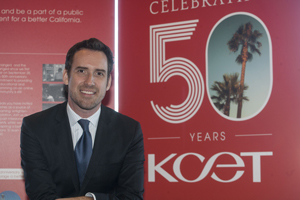
Talk about tough challenges. Michael Riley, the new president of public broadcaster KCET (Channel 28), is tasked with turning around the financially ailing and ratings-troubled L.A. TV station. Since its 2010 split from the PBS network, currently soaring on the ratings success of “Downton Abbey,” the nation’s largest independent public broadcast TV station has seen donations and viewing figures dwindle, and has struggled to find its place in the rapidly changing television landscape.
Now, in the channel’s 50th anniversary year, the Canadian executive recruited after taking ABC Family to new heights is charting a different course to raise funds and ratings by reaching out to the local community for both content and cash.
With a new broadcast facility in Burbank, improving viewing figures and wider audience reach thanks to a partnership with satellite network Link Media, the station, now known as KCET-Link, is looking to a brighter future, said Riley, 45, in his first interview since being appointed chief executive six weeks ago.
Question: So, what’s the plan?
Answer: We aim to connect with audiences like we never have before. Having had roots in this community for 50 years is a huge advantage. We are going to use our resources to tell stories happening in our local community with thoughtful, informative programming that reflects our diversity and engages our 6 million audience in California. Our partnership with Link takes us to 35 million subscribers on DirecTV and Dish. Existing KCET-Link shows like “Artbound” and “SoCal Connected” offer this opportunity.
Are you keeping all the bought-in foreign shows?
Yes. It’s a two-tiered approach. As well as providing content relevant to the local community, we bring top international television to Southern California with series like “Doc Martin,” “Death in Paradise” and “Borgen,” and bring international news here thank to our partnerships with Britain’s BBC and Japan’s NHK, allowing a pluralistic news environment. We want to curate and create more great content like this from at home and abroad.
Sounds good, but how are you going to pay for all that?
I see this job as a 50-50 split between creating programming opportunities and raising funds to pay for them. I’m confident the business community here will respond to what we’re doing. By shining a light on issues they are passionate about in the communities they serve, they will want to get involved as partners.
The station was hemorrhaging money in recent years. Has the bleeding stopped yet?
Yes. For the first time in a number a years, we are cash positive. We have been bringing in more cash – in December 2014 alone we received grants totaling $1.3 million. The target is to continue to turn the corner and build a robust business plan helped by corporate and philanthropic donations. We see a lot of light at the end of the tunnel.
What do you think of the job done by your predecessor, Al Jerome, who retired after 18 years at the helm?
On top of steering us safely through an interesting time, Al invested in our future and has done a fantastic job leaving us well-positioned with a state-of-the-art studio facility in the middle of one of the most creative communities in the world.
Viewing figures have decreased in daytime and prime time since KCET left PBS. Any signs of recovery?
Yes. The station experienced steady growth throughout 2014, and our fourth-quarter prime-time viewership was 67 percent higher than a year earlier. Whole-day viewership was 60 percent higher over the same period.
What caused KCET to split from PBS in 2010? Will you seek to reform that partnership?
Because I wasn’t here then and not familiar with what went on, it’s hard for me to comment on the past. As for the future, I’m not ruling PBS out or in. We are open to exploring partnerships with anyone who can help support our mission to bring a strong public media environment here in Southern California.
At ABC Family you captured a big, young audience in ratings and social media with hits like “Pretty Little Liars” and “Switched at Birth.” Are you targeting young audiences for KCET-Link?
We want to be as broadly targeted as possible. The plan is to engage a younger audience while continuing to bring our current audience with us. It’s all about bringing more people into our space. We will continue to build our social media to help in the effort to engage a particular part of the audience as part of that larger plan to connect with viewers like never before.
What does the 50th anniversary of KCET mean for you and your team?
An opportunity to build on a rich legacy to take public television into the 21st century with an entrepreneurial, pioneering spirit. If you don’t know where you’ve been, you don’t know where you’re going. There are exciting times ahead.
